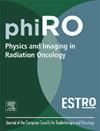通过专用成像和基于深度学习的目标和神经血管结构自动轮廓,推进离线磁共振引导前列腺放疗
IF 3.3
Q2 ONCOLOGY
引用次数: 0
摘要
背景与目的勃起功能障碍(ED)影响前列腺癌放疗后的生活质量。与计算机断层扫描(CT)相比,磁共振成像(MRI)规划提供了更好的与电位相关的解剖结构的可视化,从而提高了节约。然而,在临床实践中塑造这些结构是费时的,需要专业知识。MRI模拟的深度学习(DL)自动轮廓可以使神经血管保留放射治疗更容易获得。材料与方法对50例患者在治疗体位获得高分辨率三维t2加权SPACE MRI序列(<;1 mm3分辨率)。一位泌尿放射肿瘤学专家绘制了与勃起功能相关的解剖图(神经血管束[NVB]、阴部动脉[IPA]、阴茎球[PB]、海绵体[CC])和靶结构(前列腺[PR]、精囊[SV])。训练了40个数据集,其中10个测试了一个3D nnU-net模型。对dl生成的轮廓进行几何评估(表面Dice Score [sDSC],平均表面距离[MSD]),并通过盲法专家评审进行验证。结果dl自动分割的平均sDSC为0.82 (IPA: 0.93, NVB: 0.71, PB: 0.84, CC: 0.90, PR: 0.74, SV: 0.79),平均MSD为0.74 mm (IPA: 0.61 mm, NVB: 0.88 mm, PB: 0.63 mm, CC: 0.47 mm, PR: 0.83 mm, SV: 1.01 mm)。除阴部动脉外,盲法评分显示DL和专家轮廓之间无显著差异(平均DL与专家;NVB: 82对85;PB: 86对88;CC: 83对88;PR 81对83;SV 78对81,均p >; 0.05; IPA: 82对89;p = 0.028)。将高分辨率MRI模拟与DL后处理相结合,可以为mr引导下的SBRT规划提供准确的自动轮廓,有可能使神经血管保留放疗超越当前标准。本文章由计算机程序翻译,如有差异,请以英文原文为准。

Advancing offline magnetic resonance-guided prostate radiotherapy through dedicated imaging and deep learning-based automatic contouring of targets and neurovascular structures
Background and Purpose
Erectile dysfunction (ED) affects quality of life following radiotherapy for prostate cancer. Magnetic resonance imaging (MRI) planning provides superior visualization of potency-related anatomical structures compared to computed tomography (CT), enabling improved sparing. However, contouring these structures in clinical practice is time-intensive and requires expertise. Deep learning (DL) auto-contouring with MRI simulation could make neurovascular-sparing radiotherapy more accessible.
Material and Methods
High-resolution 3D T2-weighted SPACE MRI sequences (<1 mm3 resolution) were obtained for 50 patients in treatment position. An expert uro-radiation oncologist contoured erectile function-related anatomy (neurovascular bundles [NVB], pudendal arteries [IPA], penile bulb [PB], corpora cavernosa [CC]) and target structures (prostate [PR], seminal vesicles [SV]). Forty datasets trained and ten tested a 3D nnU-net model. DL-generated contours were geometrically evaluated (surface Dice Score [sDSC], mean surface distance [MSD]) and validated by blinded expert review.
Results
DL auto-segmentation achieved an average sDSC of 0.82 (IPA: 0.93, NVB: 0.71, PB: 0.84, CC: 0.90, PR: 0.74; SV: 0.79) and average MSD of 0.74 mm (IPA: 0.61 mm; NVB: 0.88 mm; PB: 0.63 mm; CC: 0.47 mm; PR 0.83 mm; SV: 1.01 mm). Blinded ratings showed no significant differences between DL and expert contours, except for pudendal arteries (Mean DL vs. expert; NVB: 82 vs. 85; PB: 86 vs. 88; CC: 83 vs. 88; PR 81 vs. 83; SV 78 vs. 81 all p > 0.05; IPA: 82 vs. 89; p = 0.028).
Conclusion
Combining high-resolution MRI simulation with DL postprocessing enables accurate auto-contouring for MR-guided SBRT planning, potentially advancing neurovascular-sparing radiotherapy beyond current standards.
求助全文
通过发布文献求助,成功后即可免费获取论文全文。
去求助
来源期刊

Physics and Imaging in Radiation Oncology
Physics and Astronomy-Radiation
CiteScore
5.30
自引率
18.90%
发文量
93
审稿时长
6 weeks
 求助内容:
求助内容: 应助结果提醒方式:
应助结果提醒方式:


